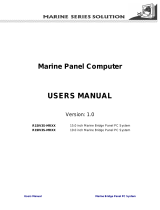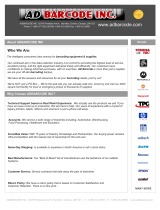Daisy Touch Screen – Glass-on-Glass Owner's manual
- Type
- Owner's manual

Innovative solutions in Touch Screen Technology
Technical Specifications for a
5 Wire ULTRA Armoured Glass
Touch Screen
1181 Parisien Street
Ottawa, Ontario, K1B 4W4
Tel: 613-742-5545
Fax: 613-742-5245
Toll Free: 1-800-463-2353
Email: info@admetro.com
www.admetro.com

Page2of9
Table of Contents
1.Mechanical Specifications..................................................................................................................4
1.1Construction Overview...............................................................................................................4
1.2Functional Overview...................................................................................................................4
1.3Connector and Cable Information............................................................................................5
1.4Armor Glass Information...........................................................................................................5
1.5Sealability.....................................................................................................................................5
1.6Material Options.........................................................................................................................5
1.6.1Connector Options..............................................................................................................6
1.6.2Coversheet Options.............................................................................................................6
1.6.3Substrate Options................................................................................................................6
1.7Advantages...................................................................................................................................6
2.Performance Specifications................................................................................................................6
2.1Input Method...............................................................................................................................6
2.2Activation Force..........................................................................................................................6
2.3Activation Accuracy....................................................................................................................7
2.4Sensor Lifespan...........................................................................................................................7
2.5Surface Hardness........................................................................................................................7
3.Optical Specifications.........................................................................................................................7
3.1Light Transmission and Reflection...........................................................................................7
3.1.1Clear.....................................................................................................................................7
3.1.2Anti-Glare............................................................................................................................7
3.1.3Anti-Reflective.....................................................................................................................7
3.2Gloss and Haze............................................................................................................................7
4.Environmental Specifications...........................................................................................................8
4.1Operating and Storage Temperature........................................................................................8
4.2Relative Humidity.......................................................................................................................8
4.3Chemical Resistance...................................................................................................................8
4.4Immersion Resistance.................................................................................................................8
4.5Fire and Burn Resistance...........................................................................................................8
4.6Altitude Resistance......................................................................................................................8

Page3of9
4.7Vibration and Shock Resistance................................................................................................8
5.Electrical Specifications......................................................................................................................9
5.1Electrostatic Discharge...............................................................................................................9
5.2Corner to Corner Resistance.....................................................................................................9
5.3Other Compliances.....................................................................................................................9
6.Product Information...........................................................................................................................9
6.1Warranty.....................................................................................................................................9

Page4of9
1. Mechanical Specifications
1.1 Construction Overview
A D Metro five-wire resistive touchscreens consist of a stackup of various different
layers of varying electrical and material characteristics. A glass substrate is used as a base
for the sensor, typically made of clear soda lime glass, along with a layer of PET
polyester used as the topsheet of the sensor. The top of the glass layer and bottom of the
polyester layer are coated with an Indium Tin Oxide (ITO) coating which have a uniform
resistance across the surface of sheet. This coating is chosen for its electrical conduction
and environmental characteristics. These two layers are separated by use of transparent
spacer dots, which are printed on the ITO surface of the glass substrate.
ULTRA touchscreens function similar to five-wire resistive technologies but have the
added bonus of a highly durable yet flexible armored glass layer laminated on top of the
polyester. It nearly doubles a standard resistive touchscreen’s lifespan by reducing the
curve at which it the top glass/polyester layer will bend, resulting in a service period
before the ITO coating begins crack from usage. The increase in pressure required for an
activation is offset by a wider dot spacing on the glass substrate.
1.2 Functional Overview
Five-wire touchscreens have electrodes at each of the four corners of the glass, to which
low voltages are delivered equally by the controller circuit. The polyester layer’s function
is that of a switch, and before any touch is made, no voltage is applied to it by any
outside sources, and is grounded. Once a touch is made, the conductive coating of the
polyester comes into contact with the conductive coating of the glass substrate. The
polyester coversheet then begins to draw current from each of the four electrodes in
Glass Substrate
Spacer Dots
Polyester
Armor Glass
Electrodes

Page5of9
various amounts, depending on the location of the touch. The current passing through
each of the electrodes is read by the controller and translated into X-Y coordinates, which
is used by the software to determine where the touch has occurred.
1.3 Connector and Cable Information
ULTRA touchscreens use Nicomatic polyester flex circuit cables constituting of five
wires with centres spaced apart by 0.1”, or 2.54 mm. The cables usually exit from the
short side of the sensor, and are typically 0.6”, or 15.24mm, wide and 15.75”, or 400mm,
long. Custom cable locations and lengths are available. They are terminated in a
Nicomatic 5 pin housing amp, with dock centres also separated by 0.1”, or 2.54mm.
These cables are highly flexible and can be bent up to a radius of 0.125”, or 3.175mm,
without affecting the touchscreen’s response.
1.4 Armor Glass Information
This flexible armor glass sheet is laminated onto the polyester coversheet on all ULTRA
touchscreens. It is 0.0039”, or 0.1mm, thick and is made of borosilicate glass, which
offers greater resistance to thermal shock than other standard glasses due to its low
coefficient of thermal expansion, and has increased protection, strength and durability.
1.5 Sealability
The watertight seal on all ULTRA touchscreens allow it to meet NEMA standards 4 and
12, and IP standard 65.
1.6 Material Options
The following options are available for all ULTRA touchscreens:

Page6of9
1.6.1 Connector Options
Possible connector housings include latching or non-latching
1.6.2 Coversheet Options
Possible polyester types include clear, anti-glare, and anti-Newton ring. Possible
armor glass coatings include clear and anti-reflective.
1.6.3 Substrate Options
Possible glass panel additions include EMI shielding, heater, PVB enhancement,
and an additional chemically strengthened glass backing.
1.7 Advantages
ULTRA resistive touchscreens make for a cost efficient solution to most touch activation
needs. ULTRA sensors are extremely resistant to many forms of punishment, including
scratches and hammer blows or blows from other blunt objects, and will continue to
function after suffering them. The sensors are extremely accurate, drift free when not in
use, and are sealed against moisture and other outside contaminants. As an added safety
feature, should the glass substrate break for any reason, the shards are held internally by
the bezel and polyester/armor glass membrane which remains unbroken, protecting the
user from harm. ULTRA provides a complete moisture barrier, which makes it ideal for
very humid environments. Moreover, its watertight seal makes it ideal for NEMA
housing applications.
The result is an extremely durable touch solution useful for almost any environment
while always remaining accurate for the sensor’s entire lifespan.
2. Performance Specifications
2.1 Input Method
Activation by finger, glove and stylus are all acceptable methods of using ULTRA
touchscreens.
2.2 Activation Force
A minimum of 85 grams of pressure is required by a finger or gloved touch in order to
produce an activation in the touchscreen. When not in use or being touched, the
touchscreen will have no activations and no drift or constant touch will be observed.

Page7of9
2.3 Activation Accuracy
A touch registered by the controller will translate to a location within 0.098”, or 2.5mm,
on both X and Y axis of where the touch occurred on the touchscreen.
2.4 Sensor Lifespan
Over 60 million touches per point can be achieved thanks to ULTRA’s layer of armor
glass.
2.5 Surface Hardness
ULTRA’s surface hardness is 6.5 Mohs.
2.6 Touchpoint Resolution
Touchpoint density depends on the controller used, but is typically 4096x4096, which
corresponds to greater than 100,000 points/inch2, or 15,500 points/cm2.
3. Optical Specifications
3.1 Light Transmission and Reflection
Depending on whether or not the ULTRA touchscreen has an anti-glare or anti-reflective
finish on its surface, the transmission and reflection rates will vary. All rates presented
are using light of wavelength 550 nm.
3.1.1 Clear
On a clear ULTRA with no options, 82% transmission can be achieved and 9%
reflection.
3.1.2 Anti-Glare
On an ULTRA with an anti-glare option, 82% transmission can be achieved and
9% reflection.
3.1.3 Anti-Reflective
On an ULTRA with an anti-reflective option, 84% transmission can be achieved
and 9% reflection.
3.2 Gloss and Haze
ULTRA has a haze rating of 2% and gloss reading of 350 GU (clear).

Page8of9
4. Environmental Specifications
4.1 Operating and Storage Temperature
When in use, ULTRA will function accurately in environments ranging from -10°C to
+55°C without suffering quality or performance issues. When not in use, ULTRA may be
stored in environments ranging from -40°C to +70°C without suffering quality issues.
4.2 Relative Humidity
Relative humidity during operation is as high as 90% non-condensing at 35°C (max).
Relative humidity during storage is as high as 90% non-condensing at 35°C (max) for up
to 240 hours.
4.3 Chemical Resistance
ULTRA is impervious to all industrial specific and everyday chemicals, solvents and
solutions that do not degrade or attack glass structure or quality, including detergents,
cleaners, alcohols, oils and foodstuffs.
4.4 Immersion Resistance
The touchscreen features a watertight seal, allowing it to continue functioning while
completely submerged.
4.5 Fire and Burn Resistance
ULTRA’s surface is unaffected by open flame, sparks, cigarette burns, or other fire
inducing objects or phenomena.
4.6 Altitude Resistance
ULTRA may be operated up to an altitude of 10,000 feet, or 3.048 km, and stored or
transported at an altitude of 50,000 feet, or 15.240 km.
4.7 Vibration and Shock Resistance
The touchscreen can withstand repeated blows from blunt objects and will still function
within specification parameters. When installed or placed in a suitable bezel housing,
ULTRA stays in accordance with UL291 standard.
4.8 Impact Resistance
The touchscreen meets UL-60950 and CSA C22.2 no 60950 (0.5kg, 50mm diameter ball
dropped from 1.3m height). For enhanced substrate touchscreens only.

Page9of9
4.9 Abrasion Resistance
ULTRA is impervious to scratches, gouges, and other surface abrasions and will continue
functioning after suffering them.
5. Electrical Specifications
5.1 Electrostatic Discharge
Per EN 61000-4-2 (1995), ULTRA can withstand 20 discharges of up to 15 kV.
5.2 Corner to Corner Resistance
ULTRA has a corner to corner resistance of range 40-60 Ohms, depending on the size of
the sensor.
5.3 Other Compliances
The overall sensor assembly is compliant with EN 60950, UL 60950, and UL 544.
6. Product Information
6.1 Warranty
ULTRA touch screens come with a 5 year warranty.
-
 1
1
-
 2
2
-
 3
3
-
 4
4
-
 5
5
-
 6
6
-
 7
7
-
 8
8
-
 9
9
Daisy Touch Screen – Glass-on-Glass Owner's manual
- Type
- Owner's manual
Ask a question and I''ll find the answer in the document
Finding information in a document is now easier with AI
Other documents
-
 Winmate R19IV3S-MR series User manual
Winmate R19IV3S-MR series User manual
-
Elo AccuTouch® 5-Wire Resistive, Zero-Bezel User guide
-
Advantech FPM-8192V/8232V User manual
-
Elo TouchSystems CRT Touchmonitors User manual
-
Hatteland Technology JH 12T01 MMC User manual
-
Elo IntelliTouch® Surface Acoustic Wave, Bezel User guide
-
Elo TouchSystems JH 10T08 User manual
-
Tyco Elo Entuitive 1725C User manual
-
Elo TouchSystems 1729L User manual
-
 Tyco Electronics 1522L-XXWB Series User manual
Tyco Electronics 1522L-XXWB Series User manual










